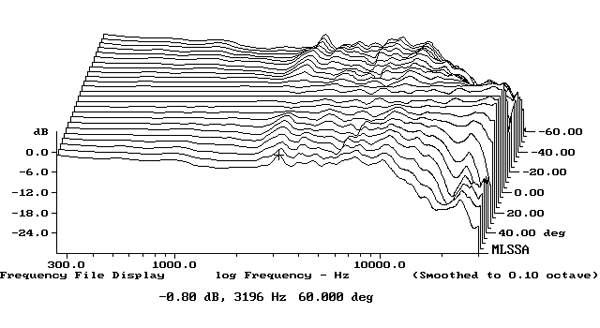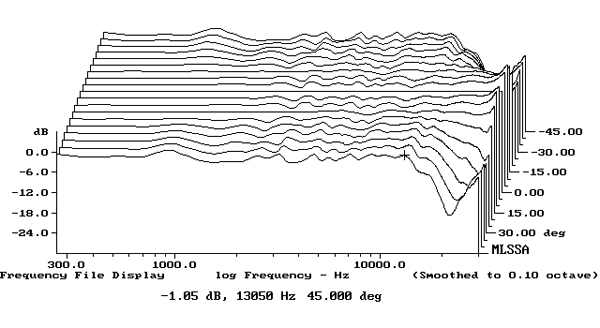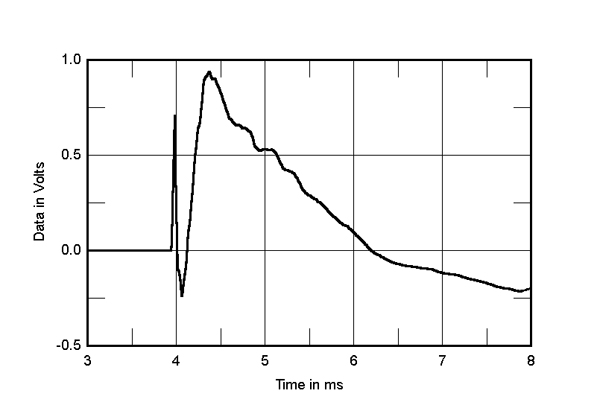Mofi sourcepoint 10 looks very good being a coaxial, see measurement at stereophile, see figure 8 here https://www.stereophile.com/content/mofi-electronics-sourcepoint-10-loudspeaker-measurements
The tweeter frequency response looks very good with no severe dips, do anyone here have first hand experience with this coaxial driver?
The tweeter frequency response looks very good with no severe dips, do anyone here have first hand experience with this coaxial driver?
The normalized dispersion charts are really interesting.


Needs some tweeter delay to get it lined up.

dave


Needs some tweeter delay to get it lined up.

dave
The step response would be great if the tweeter would run 0.2 ms late, but thats quite a bit of delay for a passive xover and would require higher order slopes to obtain. Would be interested in seeing the driver design, specifically the HF element. Suspect its crossed around 1.5k based on the impedance plot.
The tweeter is probably spaced forward of the LF acoustic center. This is where a rear mounted CD coax would be better so the HF would run later. It usually works out better that way crossover wise.
It seems they valued some other aspects more than time alignment. In general, it doesn't seem to be a high priority for most manufacturers, and blind listening tests generally seem to support that view (though personally the "ideal" speaker notions still appeal to me).
You see the same kind of time behavior in the KEF Uni-Q models also.
From the Stereophile review:
"He also discussed how, in a concentric drive unit, there's always a limit to how much magnetic energy you can get to the tweeter, which you need for it to have a high sensitivity. Andrew came up with a structure where the woofer and tweeter magnets contribute to each other's magnetic field, resulting in a greater flux density than either motor could achieve alone."
You see the same kind of time behavior in the KEF Uni-Q models also.
From the Stereophile review:
"He also discussed how, in a concentric drive unit, there's always a limit to how much magnetic energy you can get to the tweeter, which you need for it to have a high sensitivity. Andrew came up with a structure where the woofer and tweeter magnets contribute to each other's magnetic field, resulting in a greater flux density than either motor could achieve alone."
You see the same kind of time behavior in the KEF Uni-Q models also.
In most coaxes.
Coax works to solve the physical geometry and males time response easier to achieve but the time delay best provided by DSP.
dave
The driver was custom designed by Andrew Jones, just in the past year I think. No one is going to be able to have experience using it because it is not available except in that speaker.Mofi sourcepoint 10 looks very good being a coaxial, see measurement at stereophile, see figure 8 here https://www.stereophile.com/content/mofi-electronics-sourcepoint-10-loudspeaker-measurements
The tweeter frequency response looks very good with no severe dips, do anyone here have first hand experience with this coaxial driver?
I like this design. To me it feels like Retro done Right.
The tweeter is a smidge ragged, but by no means bad. The normalised dispersion out to 10KHz is very interesting.
But to get the 90/2.83V sensitivity, a big (22.5" × 14.5" × 16" (50L)) cabinet was needed. The right set of compromises for old schoolers with vinyl and tubes IMHO.
It will be interesting to see this reviewed, at some point in the future, by Erinsaudiocorner.com
@CharlieLaub
Have a look at @5th element ‘s
http://5een.co.uk/SB17Coax.htm
The idea to build our own top flight true midrange coaxial is being considered... made in small batches but at low costs for DIYers to use.
The tweeter is a smidge ragged, but by no means bad. The normalised dispersion out to 10KHz is very interesting.
But to get the 90/2.83V sensitivity, a big (22.5" × 14.5" × 16" (50L)) cabinet was needed. The right set of compromises for old schoolers with vinyl and tubes IMHO.
It will be interesting to see this reviewed, at some point in the future, by Erinsaudiocorner.com
@CharlieLaub
Have a look at @5th element ‘s
http://5een.co.uk/SB17Coax.htm
The idea to build our own top flight true midrange coaxial is being considered... made in small batches but at low costs for DIYers to use.
Attachments
Last edited:
@tktran303 That's a worthy effort and an interesting project. But the Sourcepoint 10's driver has a very advanced design. It uses a very sophisticated linear motor with a hybrid magnetic structure that serves both the woofer and tweeter. You will not be able to MacGuyver anything like that! 😀
@CharlieLaub - are you saying that the tweeter moves back and forth in the z axis plane in sync with the woofer?
Otherwise It still can’t break the laws of physics.
Let’s see the IMD with a 10” woofer modulating the effects on the tweeter.
Stereophile and ASR test only steady state (static) effects of Hz vs SPL. They do not do dynamic testing like Erin does.
Our MF+HF will do only 150Hz upwards, like the KEF Blade/Reference Meta UniQ MF+HF

For a woofer with significant x-max, + (MF) + tweeter + coincidental there’s BMS, RCF etc
Otherwise It still can’t break the laws of physics.
Let’s see the IMD with a 10” woofer modulating the effects on the tweeter.
Stereophile and ASR test only steady state (static) effects of Hz vs SPL. They do not do dynamic testing like Erin does.
Our MF+HF will do only 150Hz upwards, like the KEF Blade/Reference Meta UniQ MF+HF
For a woofer with significant x-max, + (MF) + tweeter + coincidental there’s BMS, RCF etc
Last edited:
@tktran303 : Andrew Jones give a relatively transparent overview of these and other issues in the Sourcepoint 10 whitepaper. I was referring to the distortion generated by the motor, not touching on what you brought up about modulation of the tweeter wavefront by the moving woofer cone. Physics is physics. The cone has to move to work, so you cannot eliminate that only minimize it. If you constrain the driver so that it does not need to move much by only operating above some frequency that will reduce IMD dramatically. That is also one reason why AJ used a relatively larger woofer for a coax, the largest he has ever tried or so he told me. I chatted about it with him on the phone for about an hour. It's a pretty impressive driver all in all. He designed it himself and then had them built in one of the usual MFG houses.
One of my local DIY clubs is having an event in April this year. Each year the organizer (usually forum member Wolf_Teeth) comes up with a themed competition in which some rules must be followed. These are usually about what drivers can be used or how many components can be used in the crossover, etc. This year the theme can accommodate a coaxial system, and I just happen to have a pair of 12" CerwinVega coax drivers that accept 1" thread-on compression drivers. I have a good CD on hand and the 12" driver fits in some veneered subwoofer cabs that I have as well. The driver has a triple roll surround and the CD can be crossed over below 1kHz, so I am actually hopeful that it will sound good. I did some measurements on the driver years ago but I can't find them so I need to put it all together and re-measure to know for sure. It would be a fun project that would use up these toys from my attic so my fingers are crossed!
One of my local DIY clubs is having an event in April this year. Each year the organizer (usually forum member Wolf_Teeth) comes up with a themed competition in which some rules must be followed. These are usually about what drivers can be used or how many components can be used in the crossover, etc. This year the theme can accommodate a coaxial system, and I just happen to have a pair of 12" CerwinVega coax drivers that accept 1" thread-on compression drivers. I have a good CD on hand and the 12" driver fits in some veneered subwoofer cabs that I have as well. The driver has a triple roll surround and the CD can be crossed over below 1kHz, so I am actually hopeful that it will sound good. I did some measurements on the driver years ago but I can't find them so I need to put it all together and re-measure to know for sure. It would be a fun project that would use up these toys from my attic so my fingers are crossed!
Last edited:
Yes I’m aware of Tweeter Yoga @ InDIYana 2023.
😅
You guys really like to challenge yourself.
Have fun Charlie!
😅
You guys really like to challenge yourself.
Have fun Charlie!
@CharlieLaub - I'm currently working on something similar to your design with Eminence drivers - KL3012CX that takes a screw on driver. I've got several higher end comp drivers to choose from (HF10AK, HF108, NSD1095N, CDX1-1745, DE250), so it should be very promising. Mine will have a dedicated 12" LF driver in each enclosure to take the LF load off the coax to reduce IMD. The coax will run above 100 hz in its own 1 cu ft compartment for great dynamic potential with an Eminence KL3012LF in a 3 cu ft ported partition doing the heavy LF work. The whole package should be flat down to 40 hz in a 3 cu ft cab with the coax in its own 1 cu ft space.
But that does not mean no one here have not tried this driver outThe driver was custom designed by Andrew Jones, just in the past year I think. No one is going to be able to have experience using it because it is not available except in that speaker
The floorstanding kef ls60 sounded better without time alignment then with, according to stereophile latest issueDIgital XOs really needed to line them up.
dave
Maybe you can explain how, unless the driver was in the Sourcepoint 10 iteself? The driver is not "available" for sale anywhere except as part of that speaker. The driver has just been developed recently.But that does not mean no one here have not tried this driver out
- Home
- Loudspeakers
- Multi-Way
- Mofi sourcepoint 10
